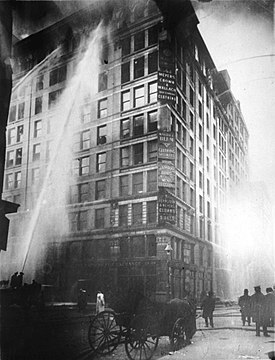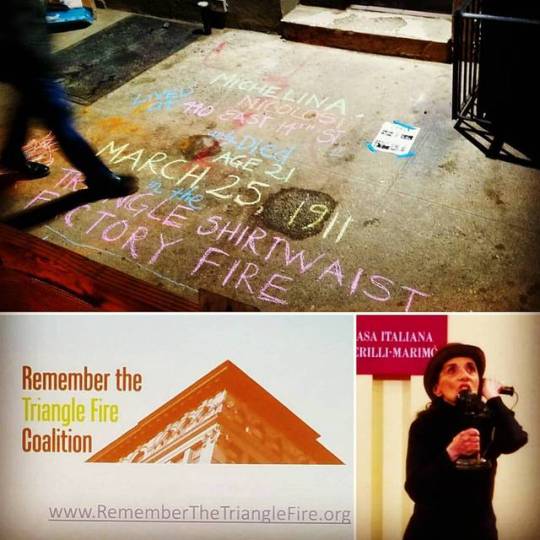#trianglefire
Text

(Pictured: Carnations laid in honor of the dead at the sidewalk of NYU's Brown Building. Photo by Leanna Renee Hieber)
On March 25, 1911, a fire broke out on the top floors of the Asch Building. The Triangle Shirtwaist Factory Fire took the lives of 146 people, most of them women and girls. As a NYC tour guide of over 15yrs, I speak about this site with vehemence. Never forget the importance of modern labor laws and the lives lost before we gained these rights. Andrea Janes and I wrote about this site, and its importance in the capacity of residual haunting, in our book A HAUNTED HISTORY OF INVISIBLE WOMEN. Our chapter on the fire, Industrial Monsters, is up on the Boroughs of the Dead blog: https://boroughsofthedead.com/industrial-monsters-ghosts-of-the-triangle-shirtwaist-factory/
Please support union workers and legislation aimed at shoring up worker protections. Honor the dead.
#nychistory#a haunted history of invisible women#on this date#labor history#trianglefire#triangle shirtwaist factory fire#factory#haunting#hauntedhistory#tour guide#new york history#labor law#labor rights#unionize
113 notes
·
View notes
Photo

"Triangle Factory Owners found Not Guilty" -- #OnThisDay December 27, 1911 after a 23-day trial, Isaac Harris and Max Blanck, "Shirtwaist Kings", who owned the Triangle Factory, are found not guilty of Murder in the death of 146 workers. The task of the jurors had been to determine whether the owners knew that the doors were locked at the time of the fire. Customarily, the only way out for workers at quitting time was through an opening on the Green Street side, where all pocketbooks were inspected to prevent stealing. Worker after worker testified to their inability to open the doors to their only viable escape route, the stairs to the Washington Place exit, because the Greene Street side stairs were completely engulfed by fire. More testimony supported this fact. Yet the brilliant defense attorney Max Steuer planted enough doubt in the jurors' minds to win a not-guilty verdict. Grieving families and much of the public felt that justice had not been done. "Justice!" they cried. "Where is justice?" Twenty-three individual civil suits were brought against the owners of the Asch building. On March 11, 1914, three years after the fire, Harris and Blanck settled. They paid 75 dollars per life lost. In August of 1913, Max Blanck was charged with locking one of the doors of his factory during working hours. Brought to court, he was fined twenty dollars, and the judge apologized to him for the imposition. In December of 1913, the interior of his factory was found to be littered with rubbish piled six feet high, with scraps kept in non-regulation, flammable wicker baskets. This time, instead of a court appearance and a fine, he was served a stern warning. The Triangle Waist Company was to cease operations in 1918, but the owners maintained throughout that their factory was a "model of cleanliness and sanitary conditions," and that it was "second to none in the country." Pictured: Max Blanck and Isaac Harris, Triangle Waist Company owners in a group portrait, possibly with Triangle factory workers and visitors. #5780P #ILGWU #Whoisguilty #TriangleFire #LaborHistory #CornellUniversity #ILR #CornellRAD #KheelCenter
#onthisday#5780p#ilgwu#whoisguilty#trianglefire#laborhistory#cornelluniversity#ilr#cornellrad#kheelcenter
0 notes
Text

#pizzapunk #pizzapunkwithextrathickcrust #punk #crust #hardcore #d-beat #ska #grind #trianglefire #trianglefireband #trianglefire13
1 note
·
View note
Text
The 108th Anniversary
Today is the 108th anniversary of the Triangle Shirtwaist Fire. On March 25th, 1911, 146 people, mostly young Jewish and Italian immigrant women lost their "American Dream" and died in the course of eighteen horrible minutes. Remember them when tempted to forgo constitutional norms in favor of political exigencies. Remember them when tempted to deny a century of social reform in the pursuit of Golden idols. We must never forget them.
(C) DE Wolf 2019

2 notes
·
View notes
Photo

Today, Wednesday, March 25 is the 109th Anniversary of the Triangle Shirtwaist Factory Fire. Each year Chalk volunteers inscribe the names and ages of the Triangle workers in front of their former homes. This year, I am participating virtually. Bettina Maiale, 18 years old, 13t Sullivan Street. We remember you. @ruthsergel #TriangleFire #SeeYouInTheStreets https://www.facebook.com/trianglefirecoalition https://www.instagram.com/p/B-KtnktFDBp/?igshid=11ve7i72p39p3
0 notes
Photo

Today, please remember the Triangle Fire of 25 March 1911. 146 immigrant workers, many of whom were Sicilian (and Italian and Jewish), perished in a garment factory fire in New York City. We have them to thank for positive changes to our labor laws, regulations for workplace safety, and fairer workers' rights. Take a moment today to thank them. Last evening, I chalked the sidewalk in honor of Michelina Nicolosi in the East Village. She perished in the fire. At an event at NYU, also last evening, we learned how we can donate to create the memorial for the site of the disaster, so future generations recall the workers' sacrifices. And, lower right, artist Lulu Lolo performed her moving tribute, Soliloquy For A Seamstress, recounting the moments of the tragedy. #rememberthetriangle #triangle #sicilianimmigrants #trianglefire #labor #experiencesicily #sicily #sicilia #siciliabedda #sizilien #italy #italia #italien #sicilytourism #sicilytravel #sicily_tourism #sicily_travel #sicilyvacation #sicilians_world #ig_sicily #siciliafoto #fotosicilia #sicilyphoto #instasicilia #gf_italy #siculamenteDoc #sicily_tricolors #ig_visitsicily #newyorkcity #nyc (at East Village, Manhattan)
#sicily_tourism#ig_visitsicily#sicilyphoto#sicilianimmigrants#instasicilia#sicily_travel#siciliafoto#ig_sicily#rememberthetriangle#labor#sicilia#sicily#italy#italia#trianglefire#sicily_tricolors#siculamentedoc#triangle#newyorkcity#siciliabedda#gf_italy#sicilytravel#sicilytourism#sicilyvacation#sizilien#experiencesicily#fotosicilia#nyc#italien#sicilians_world
1 note
·
View note
Link
See You in the Streets reveals how public historian Ruth Sergel created a recurring interactive memorial to the victims of the 1911 Triangle Shirtwaist Factory Fire, led a diverse coalition to create an open archive and epic centennial rememberance of the event that changed history for workers after decades of similar tragedies
0 notes
Photo

March 25, 1911 / March 25, 2017
Back in 2009 and 2011, I participated in FAX at the Contemporary Museum in Baltimore and the Carpenter Center at Harvard University. Artists were asked to fax their work to the traveling exhibition, which could come in at any point during the show’s run. The starting point for my contribution (one of the pages I faxed is illustrated above) was the history of the fax machine, a precursor of which was something called the telautograph, invented by Elisha Gray in 1888. Here’s Gray describing what he called the “Art of Telegraphy”:
By my invention you can sit down in your office in Chicago, take a pencil in your hand, write a message to me, and as your pencil moves, a pencil here in my laboratory moves simultaneously, and form the same letters and work.
Researching the history of telegraphy led me to various accounts of the device’s role in the tragic events of the Triangle Shirtwaist Fire.
The Triangle Shirtwaist Company occupied the eighth, ninth, and tenth floors of the Asch Building in lower Manhattan. On March 25, 1911, a fire originating on the eighth floor resulted in the death of 146 workers—mostly immigrant women ages 14 to 43.
When the fire broke out, Dinah Lipschitz, a bookkeeper on the eighth floor, rushed to sound the alarm to the company’s switchboard two floors up. Rather than picking up the telephone next to her, Lipschitz turned to the newly acquired office telautograph, wrote “FIRE!” and pressed a button to alert the switchboard to an incoming message.
Mary Alter was on duty at the company’s main switchboard. She heard the buzz and turned to the corresponding telautograph to wait for a message, but the pen never moved. Lipschitz made a second attempt a few precious minutes later using the telephone. Alter answered, but in her rush to alert management on the tenth floor, she neglected to connect Lipschitz to the ninth floor—telephone calls between floors could only be connected via the main switchboard.
In 2009, I was thinking a lot about the failed promises of technology—how we sometimes overlook what gets lost when new technologies take hold—so I was particularly struck by Lipschitz putting her trust in the newer, less tested telautograph over the known reliability of the telephone.
But an artwork’s meaning can change over time, even for the person who makes it. Today, the point I draw from the Triangle Shirtwaist Fire is the crucial role that health and safety regulations play in our daily lives. The tragedy gave new urgency to the country’s nascent labor movement and inspired activists like Frances Perkins to campaign for and implement workplace safety reforms.
We take for granted that the buildings we work, learn, or live in are constructed and maintained with basic health and safety standards. That should a fire break out, a reliable alarm will sound, and we can make our way to an unblocked escape route. The Asch Building’s locked doors, narrow exits, and its single, unsound fire escape are unthinkable today.
I don’t think the Asch Building owners or the Triangle Shirtwaist Company executives wished their tenants and employees bodily harm, but they didn’t provide reasonable safety standards because they didn’t have to. Regulations keep us accountable as well as safe.
When I originally faxed my research documents to FAX, I didn’t consider it political art. But we’re facing a new era of deregulation and living in a time in which the basic norms of human decency and empathy seem as ephemeral as Dinah Lipschitz’s scrawled “FIRE!” alarm.
0 notes
Photo

Tomorrow we will commemorate the Triangle Shirtwaist Factory fire, a tragedy caused by criminal negligence and employer greed that resulted in the horrific deaths of 146 workers. 106 years ago the fire became a call to action for the growing labor movement. Today the fire continues to serve as a call to action for us, as our civil liberties and worker rights are again under attack.
Please join us tomorrow at the 2017 Triangle Shirtwaist Factory Fire Commemoration as we commemorate our terrible loss, and commit to continue to fight back and take action for immigrant and worker rights!
0 notes
Text
youtube
Somberly wishing I had seen you sooner.
#trianglefire
0 notes
Link
There was a certain lack of care when it came to looking for Max Hochfield’s sister post factory fire. In such a desperate time, Hochfield felt a sort of insanity hitting a breaking point following his sister’s disappearance/death. His anger ended up being directed to “those in charge”, but really his devastation over losing a loved one was just something that he could not process. It made him think about just how crazy the world could be, where one day when celebrating his sister’s engagement, the following could mean never seeing her again following such a joyous celebration.
1 note
·
View note
Photo

Last week, we gave a big #CornellWelcome to our new @cornellilr students by welcoming them to the archival world of the #KheelCenter. Students got the opportunity to see a sampling of our collections, including records from Rev. Dr. Martin Luther King Jr., Ruth Bader Ginsburg, the International Ladies' Garment Workers' Union, and the Triangle Shirtwaist Factory Fire. The Kheel Center is getting involved in even more class instruction than before and we look forward to seeing our students in the reading room! #CornellRAD #LaborArchives #LaborHistory #ILRSchool #ArchivesOfInstagram #MLK #TriangleFire #ILGWU #NotoriousRBG @cornell_library #Cornell2026 https://www.instagram.com/p/ChkOrnfuV3w/?igshid=NGJjMDIxMWI=
#cornellwelcome#kheelcenter#cornellrad#laborarchives#laborhistory#ilrschool#archivesofinstagram#mlk#trianglefire#ilgwu#notoriousrbg#cornell2026
0 notes